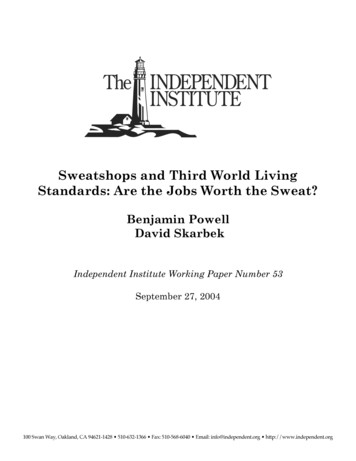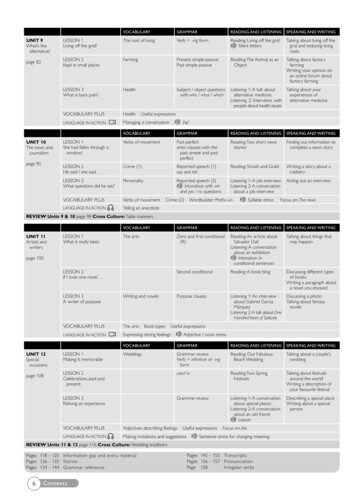
Transcription
Sweatshops and Third World LivingStandards: Are the Jobs Worth the Sweat?Benjamin PowellDavid SkarbekIndependent Institute Working Paper Number 53September 27, 2004100 Swan Way, Oakland, CA 94621-1428 510-632-1366 Fax: 510-568-6040 Email: info@independent.org http://www.independent.org
Sweatshops and Third World Living Standards: Are the Jobs Worth the Sweat?Benjamin PowellandDavid Skarbek Department of EconomicsSan Jose State UniversitySan Jose, CA 95192-0114benjamin.powell@sjsu.eduABSTRACTMany studies have shown that multinational firms pay more than domestic firms in ThirdWorld countries. Economists critical of sweatshops have responded that multinationalfirms’ wage data do not address whether sweatshop jobs are above average because manyof these jobs are with domestic subcontractors. In this paper we compare apparelindustry wages and the wages of individual firms accused of being sweatshops tomeasures of the standard of living in Third World economies. We find that mostsweatshop jobs provide an above average standard of living for their workers.Benjamin Powell is an Assistant Professor of Economics at San Jose State University and the Director ofthe Center for the Study of Entrepreneurial Innovation at the Independent Institute. David Skarbek is aneconomics major at San Jose State University and intern at the Independent Institute. The authors thankJeffery Hummel, Charles Murray, Larry Pratt and Edward Stringham for helpful comments on earlierdrafts. Financial support from the American Institute for Economic Research is gratefully acknowledged.The usual disclaimer applies.
Over the past decade U.S. firms and their subcontractors have faced protests fromstudent groups, labor leaders, and some government officials for employing sweatshoplabor. Sweatshops are generally characterized as places of employment that have lowpay, poor working conditions, and long hours. Most economists view so-calledsweatshops as a benefit to Third World workers and recognize that the anti-sweatshopactivists’ activities could reduce Third World employment and investment, thus makingworkers worse off. In response to the anti-sweatshop movement, economists in theAcademic Consortium on International Trade (ACIT), led by Jagdish Bhagwati,circulated a letter to colleges and universities urging them to become aware of thedownsides to anti-sweatshop movement demands before adopting any policies.The economic way of thinking views sweatshops from an exchange perspective inwhich both workers and employers gain when they voluntarily enter into a labor contract– no matter how low the wages may seem to external observers. From Walter Williams(2004) on the right to Paul Krugman (1997) on the left, economists across the politicalspectrum have defended sweatshops in the popular press.1 One economist critical ofsweatshops even observed that most economists’ opinion is “as simple as this: ‘Eitheryou believe labor demand curves are downward sloping, or you don’t,’ as a neoclassicalcolleague said to me. Of course, not to believe that demand curves are negatively slopedwould be tantamount to declaring yourself an economic illiterate” (Miller 2003).Not all economists support sweatshops, however. In response to the lettercirculated by ACIT, a group calling themselves Scholars Against Sweatshop Labor(SASL) circulated their own letter in support of the student anti-sweatshop movement.2
The letter had 434 signatories, 73 percent of whom were economists. At least onescholarly article by an economist, (Miller 2003) “Why Economists are Wrong AboutSweatshops,” has criticized the mainstream economic view of sweatshops.Much of the scholarly work on sweatshops has been performed by noneconomists or has limited itself to documenting the organization and activities of the antisweatshop movement. Examples include Mandle (2000), Appelbaum and Dreier (1999),and Firoz and Ammaturo (2002). Only a few economic papers have dealt directly withsweatshops. Brown, Deardorff, and Stern (2003) modeled the theoretic frameworks inwhich multinational firms could raise or lower wages. Elliot and Freeman (2001)outlined the most harmful of the anti-sweatshop activists’ demands. Moran (2002 Ch. 1and 2) documents that foreign direct investment and the firms it encourages provideabove average pay and benefits for Third World workers.Most scholarly work by economists related to sweatshops has focused on thewages multinational firms pay. Several econometric studies demonstrate the benefitsmultinational firms provide. Aitken, Harrison, and Lipsey (1996) and Lipsey andSjoholm (2001) both find that after controlling for other factors, multinational firms payhigher wages than domestic firms in Third World countries. Feenstra and Hanson (1997)find that multinational firms improve the lives of workers by increasing the demand forlabor. Budd and Slaughter (2000) and Budd, Konings, and Slaughter (2001) find that asmultinational profits go up, multinational firms share gains with Third World workers.Brown, Deardorff and Stern (2003) summarize the literature documenting the benefitsmultinational companies provide to Third World workers.1Other excellent examples include Sowell (2004) and Henderson (2000).3
Economists critical of sweatshops usually do not dispute that multinational firmspay more than domestic firms in most cases. Miller (2003) notes,The ACIT writes that multinational corporations “commonly paytheir workers more on average in comparison to the prevailingmarket wage for similar workers employed elsewhere in theeconomy.” But, as the SASL authors correctly point out, “Whilethis is true, it does not speak to the situation in which mostgarments are produced throughout the world – which is by firmssubcontracted by multinational corporations, not the MNCsthemselves (p.101).This paper expands on the existing literature by comparing sweatshop wages,without regard to whether a firm is multinational or a domestic subcontractor of such, tostandards of living in the countries in which they employ workers. We compiled a list ofcountries where U.S. news sources have reported sweatshops. The apparel industry iswidely cited in the press for using sweatshops most frequently, so apparel industry wagesin these countries are compared to average income, average wages and poverty earnings,in the next section of this paper. In the third section we compare the wages at individualfirms accused of being sweatshops with these same standard of living measures.Apparel Jobs Compared to Average Living StandardsThe apparel industry has drawn the most attention the press for its use ofsweatshop labor. Sometimes a U.S. firm directly employs Third World workers, butmore often subcontractors actually produce the products. Table 1 contains the averageapparel industry wages in countries where sweatshops supposedly exist.22Countries where at least one U.S. news source claimed sweatshops existed were included.4
Table 1. Average Hourly Apparel Worker WagesBangladeshChinaCosta RicaDominican RepublicEl ly Wage in U.S. 0.130.442.381.621.380.491.310.340.760.26Source: Globalization and the Poor , Table 7.2, p.108.Apparel industry wages are low by U.S. standards, but they compare favorablywith the average standard of living in these countries. Figure 1 shows the averageapparel worker's earnings as a percent of average per capita income. Since no datadocumenting the average number of hours worked in the apparel industry were available,we provide four estimates that vary the hours worked per week between 40 and 70. The60 and 70 hour estimates are more likely to be accurate since these employees often worklong hours and six days per week.5
Figure 1Apparel Industry Wages as a % of Avg. National Income900.0%800.0%700.0%600.0%40 h/w500.0%50 h/w60 h/w70 a RicaDominicanRepublicEl re 1 shows that if working 70 hours per week, apparel workers’ averageincome exceeds the average income in each country.3 In 9 of 10 nations, average apparelindustry income exceeds the national average at only 50 hours per week. Apparel workersin the Dominican Republic, Haiti, Honduras, and Nicaragua earn 3 to 7 times the nationalaverage.National income per capita divides the total output of the economy by the totalpopulation, both workers and non-workers. If apparel industry workers tend to be youngand without a family, or women and children, then comparing apparel wages to averageincome per capita gives a fairly accurate assessment of how they live compared to othersin their economy since their income is only supporting one person. Women and children3All data on average per capita income and labor force size used in Figures 1-4 come from the WorldBank’s World Development Indicators Online, accessed July 2004. Conversions of per capita income fromlocal currency to U.S. currency are made by the World Bank using the atlas method.6
were often the workers in 19th century U.S. and British sweatshops, and some anecdotalevidence from the Third World suggests this may be true there too.It is also useful to compare apparel industry workers' earnings to just otherworkers’ wages. Unfortunately, good wage data does not exist. To approximate averagewage data, we have used employment participation data to adjust average income percapita to reflect average income per worker. Data on labor force size do not countworkers in the informal sector, which can be quite large in these countries, but the valueof what informal workers produce is often estimated in GDP measures.4 Accordingly,our measure of earnings per worker likely overstates average income per worker and thuscauses us to understate apparel industry wages as a percent of average income perworker.4The common perception is that “everybody works” in these countries, yet because much of the work is inagriculture or the informal sector, many workers are not counted in the official labor force participationnumbers used here.7
Figure 2Apparel Industry Wages as a % of Avg. National Income Per Worker350.0%300.0%250.0%200.0%40 h/w50 h/w60 h/w70 h/w150.0%100.0%50.0%0.0%BangladeshChinaCosta RicaDominicanRepublicEl re 2 shows that despite this bias, average apparel industry wages equal orexceed average income per worker in 8 of 10 countries. At 70 hours of work per week,apparel worker earnings in six countries exceed 150 percent of average income perworker, and they more than double the average in three countries.We can also compare apparel industry earnings to the dire poverty in thesecountries. Table 2 reports the World Bank’s estimated percent of the population thatlives on less than 1 and 2 per day. In most of these countries more than half thepopulation lives on less than 2 per day. Yet, in 9 of 10 countries, working 10 hour daysin the apparel industry lifts employees above (and often far above) the 2 per daythreshold. Even in the one exception, Bangladesh, working 10 hour days in the apparelindustry results in earning more than the 36% of the population living on less than 1 perday.8
Table 2. People Living on Less than 1 a Day 2 a 7%BangladeshCambodiaChinaCosta RicaDominican RepublicEl SalvadorHondurasIndonesiaNicaraguaVietnamSource: World Bank, World Development IndicatorsData for the most recent year available were used foreach country. Currency conversions by PPP.The apparel industry has been widely criticized for “exploiting” Third Worldworkers in sweatshops, but the data show that these workers are better off than mostpeople in their countries. Although the apparel industry as a whole pays better, antisweatshop activists sometimes single out particular firms as exploitative. We next look atexamples in which specific firms have been protested for being sweatshops.Wages in Sweatshop Firms Compared to Living StandardsOur data come from popular press articles that document sweatshop wages. 5Many of the wages quoted come directly from anti-sweatshop activists. Thus, any biaswould understate the actual level of compensation.6 Despite this, we find that whencompared to per capita income in these countries, most sweatshops pay more than theaverage standard of living.5Branigin (1998), Eversley (2000), Foster (2001), Greenhouse (1996), Greenhouse (2001), Grow (2000),Hayden and Kernaghan (2002), Hiam-White (1998), Holstrom (1996), Jones (1996), Kaufman andGonzalez (2001), Kennel (1996), Mallick (1997), Meyer (1997), National Labor Committee (2004),O’Connor (1995), Pabst (2000), Sneider (2000), Stelzer (1996), St. Petersburg Times (1996), Tracinski(2000), Washington Post (2002), Wells (2004), Williams (2004).6Each article converted domestic wages into U.S. prices without mentioning the exchange rate methodused for conversion. Two articles may quote different wages when referring to the same case because of9
Table 3 lists the wages that sweatshop workers reportedly earn and, whenavailable, the company involved. These wages are obviously quite low compared to thosein the U.S., but a high percentage of people in these countries earn less than 1 or 2 perday. In 41 of 43 cases, working 10 hour days results in earning more than 1 per day, andin more than half the earnings are greater than 2 per day. Sweatshop wages raiseworkers' standard of living higher than a significant fraction of the population.different methods of conversion. When we identified multiple articles referring to the same case, weincluded the individual sweatshop only once in our sample.10
Table aChinaCosta RicaDominican RepublicEl SalvadorEl SalvadorEl 00200420001997CompanyMary Kate & AshleyMary Kate & AshleyReported Wages.18 p/hour.08 p/hour.25 p/hourNBA.14 p/hourNBA.07 p/hour2 p/dayNFL, NBA, MLB.165 p/hourNBA.16 p/hour.12 p/hour.20 p/hour.15 p/hour.13 p/hour.30 p/hourNike1.75 p/day16 p/month25 p/monthRawlings Baseball1.12 p/hour.69 p/hourGap.55 p/hourGap.60 p/hourGap30 p/week.55 p/hourDisney.28 p/hourP Diddy.75 p/hourLevi's and Nike5.40 p/dayWal-Mart/Kathie Lee .31 p/hour.30 p/hourNike.27 p/hourNike2.46 p/dayNike2.28 p/day117 p/monthNike115 p/monthNike.14 p/hourNike.22 p/hourNike.45 p/hour135.50 p/weekKohl's dept. stores3 p/day.17 p/hour.19 p/hour.20 p/hourNBA.15 p/hourNike564 p/yearNike1.60 p/day11
Figure 3 shows average reported sweatshop wages as a percent of each country’saverage income.7 Since many news articles contained hourly wage data without statingthe number of hours worked, we again created four estimates that vary hours worked perweek between 40 and 70. When articles reported daily wage data, we based ourcalculation on six days of work per week. The 40 hour estimate is probably low againsince most sweatshop employees work long hours and often work six days per week.When articles provided estimated hours of work, most were in excess of 70 per week; weincluded the actual hours in the 70 hour estimate when they were available.Figure 3Avg. Protested Sweatshop Wages as a Percent of Avg. National Income400.0%350.0%300.0%250.0%40 h/w50 h/w60 h/w70 h/w200.0%150.0%100.0%50.0%0.0%Banladesh CambodiaChinaCosta Rica DominicanElHaitiHonduras Indonesia NicaraguaRepublic SalvadorNote: In Cambodia only weekly sweatshop wage data was available, so the various hourly estimates are not neededVietnam7We compared each reported sweatshop wage with the average income in the year for which the wage wasreported. To compare average sweatshop earnings to average income for a country without biasing theresults, we also averaged the per capita income data for each observation. For example, if a country hadtwo reported sweatshop cases in 1996, one in 1997 and one in 2000, we averaged those wages andcompared to [(GNI 1996) (GNI 1996) (GNI 1997) (GNI 2000)] / 412
In 9 of 11 countries, the reported sweatshop wages equal or exceed averageincome, doubling it in Cambodia, Haiti, Nicaragua, and Honduras (at 70 hours).However, these figures do not include non-monetary compensation. Nike’s employees inIndonesia, for example, receive free health care and meals in addition to their wages(Jones 1996). Since 7 of 8 Indonesian examples alleged Nike factories to be sweatshops,not including non-monetary compensation causes our Indonesian sweatshop wageestimates to appear far lower than they should. If firms in other countries also provideadditional benefits, their wages may be similarly understated. Overall, even with our datalimitations, Figure 3 demonstrates that most of the jobs that some anti-sweatshopadvocates protest raise their workers' standard of living above their nation's average.The above figure compares sweatshop wages with average income for bothworkers and non-workers. We can again make the adjustment, with the same datalimitations as before, to compare protested sweatshop jobs with average income perworker. Due to not counting the large informal sector, we are again likely understatingsweatshop earnings as a percent of average earnings per worker. The bias that our dataoften come directly from those with the most incentive to understate earnings alsoremains.13
Figure 4Avg. Protested Sweatshop Wages as a Percent of Avg. National Income Per Worker180.0%160.0%140.0%120.0%40 h/w50 h/w60 h/w70 h/w100.0%80.0%60.0%40.0%20.0%0.0%Banladesh CambodiaChina Costa Rica DominicanElHaitiHonduras Indonesia NicaraguaRepublic SalvadorNote: In Cambodia only weekly sweatshop wage data was available, so the various hourly estimates are not neededVietnamFigure 4 shows that the average protested sweatshop worker earns more than theaverage worker in Cambodia, Haiti and Nicaragua. In most countries the protested wagesare more than 60 percent of the average. It is important to remember the biases andlimitations of this data when comparing these numbers.In addition, the relevant comparison facing an individual worker is not averagewages but individual alternatives. Sweatshops make a worker better off when they paymore than that specific worker’s next best alternative. Thus, even where earnings are lessthan 100 percent of average wages, as long as workers voluntarily choose to work at thesweatshop, it makes the individual worker better off.Some caution should be used when looking at the data for China. A few articlesreported that the Chinese government "forced" people to work in sweatshops. If this istrue, then we cannot assume that the jobs make the workers better off. Since the extent to14
which the Chinese examples were voluntary or coerced was unclear, we averaged themall. As such, coerced labor may be causing their reported wages to be a lower percent ofaverage income than other countries.ConclusionFew dispute that multinational firms tend to pay their workers more thandomestic firms in the Third World. Critics of sweatshops maintain that becausesubcontractors make many products for multinational firms, measuring onlymultinational firm wages does not address critics' complaints against sweatshops. Wehave addressed the deficiency in the literature by comparing apparel industry wages incountries that supposedly have sweatshops and the wages of individual firms accused ofbeing sweatshops to measures of average standards of living in these countries. The dataclearly show that overall, apparel industry workers are far better off than most people intheir economies. However, while the best available, the data used was far from perfect.Biases are likely causing us to understate earnings as a percent of living standards.Despite data limitations, individual firms accused of paying sweatshop wages often stillcompare favorably with other standard of living measures.15
ReferencesAcademic Consortium on International Trade (2000) s/Anti-SweatshopLetterPage.htmlAppelbaum, Richard and Dreier, Peter (1999) “The Campus Anti-SweatshopMovement.” The American Prospect. No. 46, Sept/Oct, pp.71-78.Aitken, Brian, Harrison, Ann, and Lipsey, Robert (1996) “Wages and ForeignOwnership: A Comparative Study of Mexico, Venezuela, and the United States.”Journal of International Economics. Vol. 40, pp. 345-371.Branigin, William (1998) “Chinese Sweatshops Labor for U.S. Retailers.” TheWashington Post. March 19.Brown, Drusilla, Deardorff, Alan, and Stern, Robert (2003) “The Effects of MultinationalProduction on Wages and Working Conditions in Developing Countries.” NBERWorking Paper 9669. Cambridge: National Bureau of Economic Research.Budd, John, Konings, Jozef, and Slaughter, Matthew (2002) “International Rent Sharingin Multinational Firms.” NBER Working Paper 8809. Cambridge: NationalBureau of Economic Research.Budd, John and Slaughter, Matthew (2000) “Are Profits Shared Across Borders?Evidence on International Rent Sharing.” NBER Working Paper 8014.Cambridge: National Bureau of Economic Research.Elliott, Kimberly and Freeman, Richard (2001) “White hats or Don Quixotes? HumanRights Vigilantes in the Global Economy.” NBER Working Paper 8102.Cambridge: National Bureau of Economic Research.Eversley, Melanie (2000) “McKinney says military buys from sweatshop.” The AtlantaJournal and Constitution. December 6.Feenstra, Robert and Hanson, Gordon (1997) “Foreign Direct Investment and RelativeWages: Evidence from Mexico’s Maquiladoras.” Journal of InternationalEconomics. Vol 42, pp. 371-393.Firoz, Nadeem and Ammaturo, Caren (2002) “Sweatshop Labour Practices: The BottomLine to Bring Change to the New Millennium Case of the Apparel Industry.”Humanomics, Vol. 18, No.1-2, pp.29-45.Foster (2001) “No sweatshops, please.” Milwaukee Journal Sentinel. January 7.Greenhouse, David (1996) “A Crusader Makes Celebrities Tremble.” The New YorkTimes. June 18.16
Greenhouse, Steve (2001) “Big-League Caps and Labor Flaps.” The New York Times.August 21.Grow, Doug (2000) “Sweatshop opponents keep up the pressure on Kohl’s; Members ofSt. Thomas the Apostle add their voices with Christmas messages to executives.”Star Tribune. December 25.Hayden, Tom and Kernaghan, Charles (2002) “Pennies an Hour, and No Way Up.” TheNew York Times. July 16.Hiam-White, Hether (1998) “A Look at Manufacturing Christmas: Their Labor, OurGifts, Your Choices.” The Washington Post. December 20.Henderson, David (1997) “The Case for Sweatshops.” The Weekly Standard. February 7.Available: erson 200.htmlHolmstrom, David (1996) “One Man’s Fight Against Sweatshops.” Christian ScienceMonitor. July 3.Jones, Del (1996) “Critics tie sweatshop sneakers to ‘Air’ Jordan” USA Today. June 6.Kaufman, Leslie and David Gonzalez (2001) “Made in Squalor: Reform has limits.” TheNew York Times. April 24.Kennel, Paul (1996) “The Sweatshop Dilemma.” Christian Science Monitor.August 21.Krugman, Paul (1997) “In Praise of Cheap Labor, Bad Jobs at Bad Wages are BetterThan No Jobs at All.” Slate. March 20.Lipsey, Robert and Sjoholm, Fredrik (2001) “Foreign Direct Investment and Wages inIndonesian Manufacturing.” NBER Working Paper 8299. Cambridge: NationalBureau of Economic Research.Mallick, Heather (1997) “Stop the World I Want to Get Off.” The Toronto Sun. January26.Mandle, Jay (2000) “The Student Anti-sweatshop Movement: Limits and Potential.”Annals of the American Academy of Political and Social Science. Vol. 570,pp. 92-103.Meyer, Tara (1997) “No widespread abuse at Nike’s Asian Plants.” Chicago Sun-Times.June 25.Miller, John (2003) “Why Economists Are Wrong About Sweatshops and the17
Antisweatshop Movement.” Challenge. Vol. 46, No. 1, pp. 93-122.Moran, Theodore (2002) Beyond Sweatshops. Washington, DC.: Brookings InstitutionPress.National Labor Committee (2004) “Sean John’s Sweatshops.” May l Labor Committee (2004) “Toys of Misery 2004.” May 28.http://www.nlcnet.org/campaigns/he-yi/.National Labor Committee (2004) “Baseball Workers Cry Foul.” May 28.www.nlcnet.orgNational Labor Committee (2004) “Bangladeshi Workers Deserve Maternity Rights.”May 28. http://www.nlcnet.org/ .National Labor Committee (2004) “Why Is the NBA Exploiting 7-cent-an-hour & SlaveLabor, And Supporting Brutal Military Dictators and Drug Lords in Burma?”May 28. http://www.nlcnet.org/campaigns/nba/ .O’Connor, Anne-Marie (1995) “The Plight of Women Around the World; CentralAmerica; Labor: Sweatshops meet U.S. consumer demand.” The Atlanta Journal andConstitution. September 3.Pabst, Georgia (2000) “Nicaragua union leader seeks support for garment workers.”Milwaukee Journal Sentinel. June 20.Scholars Against Sweatshop Labor (2001) www.umass.edu/epri/sasl/petition.htmSneider, Jaime (2000) “Good Propaganda, Bad Economics.” The New York Times. May16.Sowell, Thomas (2004) “Third World Sweatshops: Why Cambodian Workers Bribe for‘Sweatshop’ Jobs.” Capitalism Magazine. January 27.Stelzer, Irwin (1996) “Sweatshops put heat on bosses.” Sunday Times. July 28.St. Petersburg Times (1996) “Celebrities should endorse products made in America.”June 13.Tracinski, Robert (2000) “Sweatshops or opportunity for the Third World’s poor?” TheSan Diego Union-Tribune. June 1.Washington Post (2002) “For Some, an Uncomfortable Fit.” May 14.18
Wells, Jennifer (2004) “T-shirt maker struggles with sweatshop visuals.” The TorontoStar. February 29.Williams, Walter (2004) “Sweatshop Exploitation” National Column available 4/sweatshop.html. January27.World Bank (2004) World Development Indicators Online. www.worldbank.org/data19
in the apparel industry lifts employees above (and often far above) the 2 per day threshold. Even in the one exception, Bangladesh, working 10 hour days in the apparel industry results in earning more than the 36% of the population living on less than 1 per day. Figure 2 Apparel Industry Wages as a % of Avg. National Income Per Worker 0.0% 50 .










